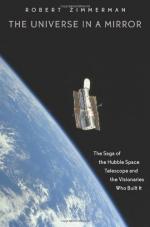|
This section contains 2,120 words (approx. 8 pages at 300 words per page) |

|
Space-based observatories are telescopes located beyond Earth, either in orbit around the planet or in deep space. Such observatories allow astronomers to observe the universe in ways not possible from the surface of Earth, usually because of interference from our planet's atmosphere. Space-based observatories, however, are typically more complicated and expensive than Earth-based telescopes. The National Aeronautics and Space Administration (NASA) and other space agencies have been flying space observatories of one type or another since the late 1960s. While the Hubble Space Telescope is the most famous of the space observatories, it is just one of many that have provided astronomers with new insights about the solar system, the Milky Way galaxy, and the universe.
 The Hubble Space Telescope (HST) is lifted into position by the Remote Manipulator System (RMS) from its berth in the cargo bay of the Earth-orbiting space shuttle Discovery.
The Hubble Space Telescope (HST) is lifted into position by the Remote Manipulator System (RMS) from its berth in the cargo bay of the Earth-orbiting space shuttle Discovery.
The Advantages and Disadvantages of Space-Based Telescopes
|
This section contains 2,120 words (approx. 8 pages at 300 words per page) |

|


